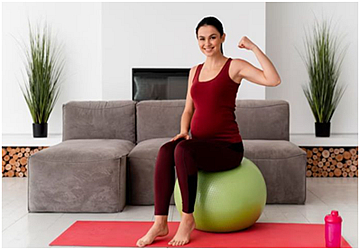Unlock the essentials of postpartum exercise with our comprehensive What You Need To Know About Postpartum Exercise Maternal Fitness Guide, safe practices, and practical strategies for regaining fitness after childbirth. Empower your journey to recovery and wellness with our dedicated guide.
The arrival of a new baby is both a joyous and trying time for the whole family. Getting back in shape after giving birth is one such obstacle. Our 'Maternal Fitness Guide' is packed with helpful information for new mothers about how to get back into shape after giving birth. Recovery from childbirth and general health can be significantly improved with the help of sensible exercise regimens that consider the changes your body has undergone and emphasize gradual improvement. Come with us as we explore the core principles of postpartum fitness, outlining a path to regaining strength and vitality.

Recognizing the Changes and Challenges
Some of the many ways in which your body may alter during and after pregnancy and childbirth are how you'll feel about working out again. Recognizing these shifts is the first step in returning to fitness after giving birth. Joints, for example, may become more mobile but more vulnerable to damage due to hormonal shifts. There is a need for rest and recovery after giving birth through physically taxing procedures like a C-section.
The Importance of Postpartum Workouts
Physical and psychological recovery can both benefit from postpartum workouts. Postpartum depression can be treated with regular exercise, which also increases energy, strengthens and tones abdominal muscles, and improves mood. It's vital to keep in mind that every woman heals at her own pace, so having patience is essential when getting back into shape.
Creating Your Maternal Exercise Plan
Choose a maternal exercise that you will perform and like doing. The objective is to get back to where you were physically before you got pregnant but also to have fun doing it. Walking, postnatal yoga, Pilates, swimming, and strength training are all excellent forms of exercise for new mothers. Get your doctor's okay before beginning any new workout program.
New Mom Workouts: Starting Slowly
Regarding exercise routines, "slow and steady wins the race" is more applicable than ever for new mothers. New mom workouts, including pelvic floor exercises or mild walking, are suggested as a starting point. Your workouts might become more strenuous as your strength and endurance increase. To avoid complications or setbacks in your recovery, it is essential to listen to your body and recognize symptoms of exertion, such as severe exhaustion, heavy bleeding, or pain.
Integrating Post-Baby Exercises Into Your Daily Routine
When you're responsible for the care of a new baby, it might be challenging to find time for physical activity. On the other hand, you can easily incorporate post-baby exercise into your regular regimen. You can stretch while your kid is sleeping or participate in fun activities with your child that also count as exercise for you. Another option is to play with your child. In addition, you should think about asking your partner or a member of the family for assistance to have some time for yourself while they take care of the infant.
The Role of Nutrition in Postpartum Fitness
Nutrition is an often-overlooked part of postnatal exercise. To help you heal after childbirth and sustain nursing, your body needs a higher nutrient intake in the postpartum period. You may receive the energy you need for your new mom's workouts and recover more quickly if you eat a balanced diet of fruits, vegetables, lean meats, whole grains, and healthy fats.
It's important to remember that your body needs time and proper nutrition after giving birth to a baby, not just a quick drop in weight. Crash diets and severe calorie restrictions should be avoided since they might adversely affect you and your baby.
Staying Hydrated: The Foundation of Maternal Exercise
When exercising after giving birth, it is essential to drink plenty of water. It helps keep the heart healthy, the muscles flexible, and the joints functioning properly. Getting enough fluids after giving birth might also aid with fatigue recovery. If you're nursing, drink enough water since your body needs more fluids to make milk.
Managing Expectations: The Reality of Postnatal Fitness
Although hearing about renowned women who, only a few short weeks after giving birth, appeared to have returned to their bodies before they had children can be motivating, it is essential to remember that this is not the norm of postnatal fitness. It takes most women anywhere from six months to a year to get back into the shape they were in before they became pregnant.
Your body requires relaxation and healing after undergoing such intense change for the past nine months. While going through this, be gentle and give yourself time and grace to overcome it.
Postpartum Mental Health and Fitness
The term "fitness" refers to more than only the body; it also refers to the state of the mind. Postpartum depression, also known as PPD, is a syndrome that affects a significant number of women after they have given birth. Endorphins are the body's natural mood boosters, and research has shown that regular exercise might help reduce some of the symptoms of postpartum depression (PPD).
If, on the other hand, you find that your feelings of depression, anxiety, or overwhelm are chronic, you must consult a healthcare expert. A comprehensive treatment strategy, including therapy and medication, can benefit from adding exercise as an adjunctive treatment modality.
Conclusion
Postnatal fitness involves time, self-care, and professional supervision. Postpartum workouts, a personalized maternal exercise plan, and daily new mom workouts aren't only about restoring your pre-pregnancy figure. You're also improving your health, well-being, and vitality for your new baby. Consult a doctor before starting a workout program. There's no "one-size-fits-all" workout plan. This guide will help you understand and practice postnatal exercise on your path to health and wellness.







